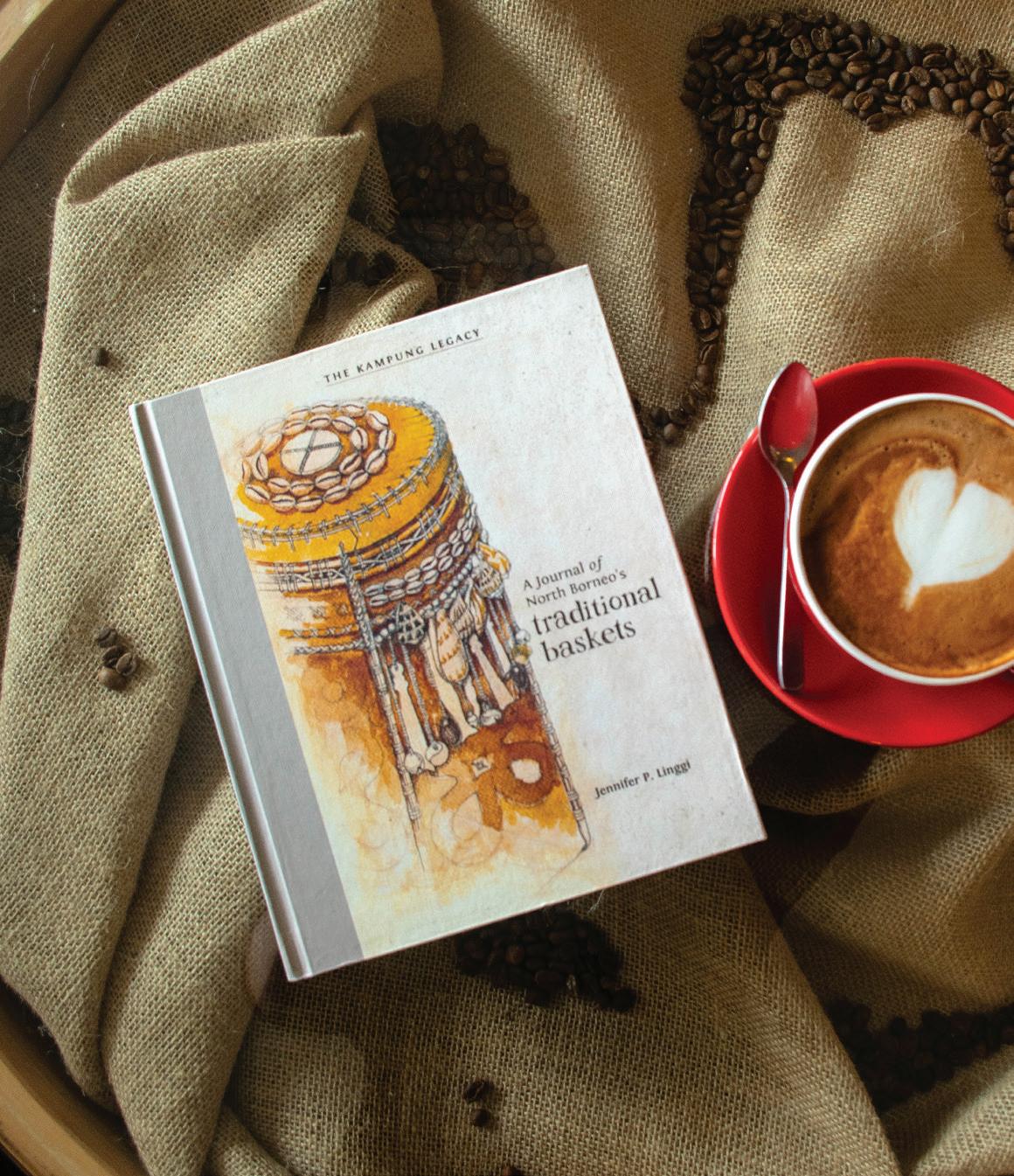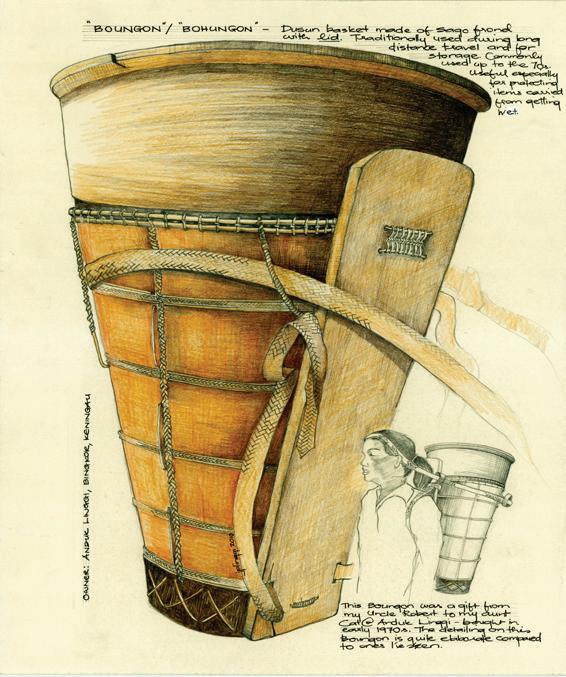
7 minute read
personality
Jennifer P. Linggi
Weaving A Future For Traditional Baskets
Advertisement
History is not only penned in writings but also in paintings, carvings, sculptures and even baskets. A close to home example is Sabah’s traditional crafts. It tells you stories and lessons of our ancestors that define who we are. Unfortunately, it is slowly diminishing.
Breeze had the opportunity to sit down with Jennifer Linggi, a passionate woman in a mission to revive our slowly fading crafts through her second edition of “The Kampung Legacy”; a ten years in the making journal that focuses on the dying craft of traditional baskets.

Jennifer’s interest in local crafts was through her mother’s involvement in a handicraft shop. After spending 20 years abroad, she noticed not many books have been published on our traditional crafts. In 2006, starting from one basket sketch after another, Jennifer became mesmerized by the intricate details, skilled knowledge and the stories behind our traditional baskets. Determined to document these skills, Jennifer would go on days or even weeks to places such as Long Pasia, Kudat, Tawau and Sipitang; to interview basket weavers and to experience the process of basket weaving.
Staying with the communities helped her to see what the baskets meant to the people and how they were used on a daily basis. Throughout her journey, she discovered our baskets have different names, uses, patterns and shapes depending on each ethnic group. For example, padi carrying basket is called Buan in Lundayeh.
by Ceaserlyn Jindan Image | ChrisCanShoot
Born and raised in Kota Kinabalu, Jennifer Linggi grew up with a strong passion for arts and aspired to be an artist or an art teacher. Both of her parents encouraged her love for art but her late father wanted Jennifer to have a strong education foundation as well. So, her late father suggested that she study Architecture. Sadly, her father passed away before she received her scholarship. Honoring her father’s advice, Jennifer pursued a postgraduate diploma in Architecture at Oxford Brookes University. She spent the next 20 years studying and working abroad. When she came back, she became a part time lecturer, later working full time as a curator for Sabah Art Gallery and now as the Deputy of General Manager for Sabah Cultural Board. Her proudest achievement is bringing Sabah Arts to a global network such as promoting it to the U.S Embassy & Japan.


The most memorable part of her journey was the warmth and willingness of the people to share their knowledge and skills. She was also struck by the mastery of the skills required to produce the baskets. A skill that has only been handed down verbally. Hence the need to visually document this dying art. The first three years were easy because as a part-time lecturer, she had more time for her research and finished about 50 sketches. Work slowed down as she became full-time curator at the Sabah Art Gallery. There were times when she was close to giving up but eventually her perseverance paid off and finally able to press the ‘send’ button to the printers just before midnight on 31 December 2016, making the 10-year research complete.
What’s interesting about Jennifer’s journal is how the illustrations compliment her work as if you’re reading a diary and the basket sketches allow the reader to have more appreciation for our traditional crafts. Jennifer sees art, not only as a reflection of ourselves but also as a form of documenting history for the future generation to learn and be proud of their unique identity. Living in a fast-paced world, we are so caught up with the race that we forget to appreciate the beauty of our culture. Jennifer hopes this journal serves as a reminder that our traditional crafts are now “in the hands of an ageing population” and 80% will be extinct if we do not pass on the knowledge to the future generation. She hopes through her work people will use traditional crafts in a contemporary way, to encourage the younger generation and artisans to revive the craft.


Jennifer is now working on her second book in her Kampung Legacy series which is on traditional textile. In the meantime, check out Jennifer’s book which can be purchased at the Sabah Art Gallery and the Sabah Cultural Board. She can also be contacted on jplinggi@yahoo.co.uk
FUN FACT: Jennifer P. Linggi is the conceptual designer for the Sabah Art Gallery building which is the first green building in Sabah and green public gallery in Malaysia.

How to Thrive in the New Norm
Welcome to the New Norm ladies and gentlemen! So what can we expect and how can we adapt to this? Throughout these past few months I’ve encountered inspiring people and companies who thrived in spite of the circumstances and are riding this tsunami wave of a crashing economy. Let me share with you some of their stories, including one of ours embedded in three keys to thriving in the new norm:
Be Comfortable Of Letting Go What You Embraced Yesterday:
It is difficult to let go of what we know. For example, IEC’s further studies consultancy has taken a huge hit as international borders close and students are forced to be homebound at least for the majority of this year.

We decided that instead of waiting for the borders to open up again or succumb to online learning which has its limits, we have applied to be one of the first NCUK International Foundation centres in Sabah. The NCUK Foundation is a PreUniversity Foundation qualification which will provide students with a certificate to progress onto University studies, and at a fraction of the cost!
We need to recognise that business as we know it will and has already changed, and if we keep embracing and hanging onto the past, we ourselves will BE the past!
by Jasmine Leong CEO of IEC - Study English, Study Abroad Centre in Kota Kinabalu Images | Unsplash Believe There Is ALWAYS An Answer:
I heard of a pizza place in the USA that was losing business due to the lockdown. The first place to look for an answer is to see what you already have – what are your resources? Your skills? Your assets? They discovered that their oven could generate enough heat to produce PPE masks for front-liners! They changed their business using the resources they had! What happens after the pandemic you ask? They may go back to pizza baking only or they could have two businesses! Take heart, there is ALWAYS an answer.

Be Comfortable with Half-Baked Ideas:
When I was studying musical theatre in New York a few years ago, our drama teacher encouraged us to present ideas to try out new moves or directions of a scene. There are no bad ideas, he said. The important thing is to try it out. We realised that a silly half-baked idea led to other ideas and that led to a few more ideas and formed into a fully-baked idea by the end of it!
Remember that trying many things increases your odds of being successful!
I’m sure we can all attest that if there is any time to be creative, it’s NOW! One of my good friends and fitness coach, Hazli is an amazing example. A ‘14A’ SPM Top student, fellow actor, fitness trainer, gym-owner and tuition centre principal proceeded with his half-baked idea of having his own wholesome bakery!
His baking machinery arrived just before MCO and he became known as the Six-Pack Baker who took the term thriving in the new norm to a whole other level!
So, how do we thrive in the new norm? Be comfortable letting go of what you embraced yesterday, believe there is ALWAYS an answer and finally be comfortable with half-baked ideas, your best is yet to come!

Jasmine Leong is the CEO of IEC, School of English Language and Further Studies Consultancy and Principal of IEC Baby Ballet. She is also a certified trainer and coach by the John Maxwell Team. Feel free to connect with her on jasmine@iec.com.my or check out www.iec.com.my











